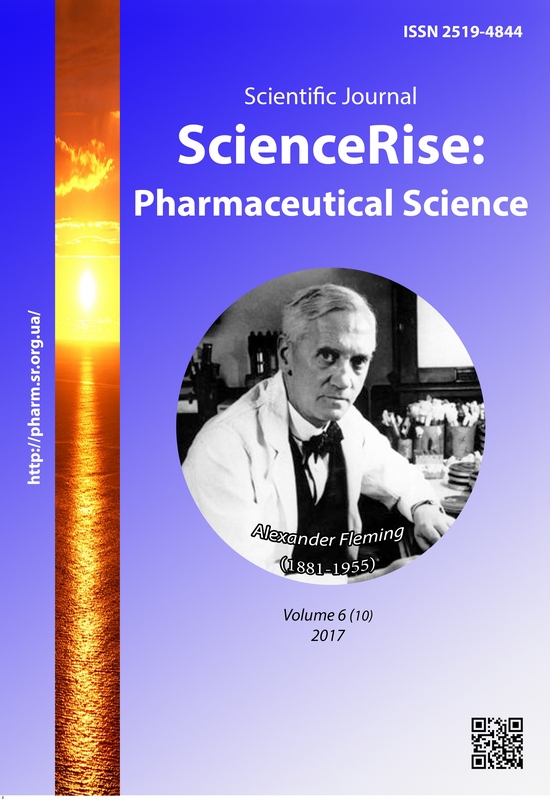Identification and quantitative determination of steroidal compounds in the plant material of cabbage
DOI:
https://doi.org/10.15587/2519-4852.2017.118169Keywords:
cabbage, leaves, seeds, heads, steroidal compounds, gas chromatography, mass-spectrometryAbstract
Vegetable crops are inexhaustible source of biologically active compounds. Cabbage (Brassica oleracea L.) – is a plant that has been extensively used in folk medicine of different countries of the world for the treatment of various disorders, and has anti-inflammatory, expectorant, broncholytic, diuretic, and genera tonic effect. The plant material of cabbage in not officinal in Ukraine, thus it requires a complex pharmacognostic research to be carried out.
The aim of the research. Identification and quantitative determination of steroidal compounds in the leaves, seeds and heads of cabbage.
Materials and methods. Identification of steroidal compounds and determination of their quantity in the plant material of cabbage was carried out using gas chromatography/mass-spectrometry (GC/MS) method.
The results of the study and their discussion. As a result of the carried out experiment 3 compounds of steroidal nature were identified in the leaves of cabbage of “Snow-white” variety, and 4 – of “Ukrainian autumn” and “Yaroslavna” varieties, 4 compounds in the seeds of cabbage of “Snow-white” variety, 3 – of “Ukrainian autumn” and “Yaroslavna” varieties, and 3 steroidal compounds in the heads of cabbage of all the varieties. β-Sitosterol was the dominating compound by the content in all studied samples. Its highest content was found in the leaves (2499 mg/kg) and seeds (1728 mg/kg) of cabbage of “Yaroslavna” variety, as well as in the heads (1148 mg/kg) of cabbage of “Ukrainian autumn” variety.
Conclusion. Results of the experiment can be used at the quality control methods for the cabbage plant material development as well as obtaining prospective biologically active substances from the studied plant material
References
- Arnoldi, A. (2004). Functional foods, cardiovascular disease and diabetes. Cambridge: Woodhead Publishing, 488. doi: 10.1201/9781439823385
- De Stefani, E., Boffetta, P., Ronco, A. L., Brennan, P., Deneo-Pellegrini, H., Carzoglio, J. C., Mendilaharsu, M. (2000). Plant Sterols and Risk of Stomach Cancer: A Case-Control Study in Uruguay. Nutrition and Cancer, 37 (2), 140–144. doi: 10.1207/s15327914nc372_4
- Lockwood, B. (2007). Nutraceuticals: A quide for healthcare professionals. Vol. 5. London: Pharmaceutical Press, 426.
- Hall, R. D., de Vos, R. C. H., Ward, J. L. (2010). Plant metabolomics applications in the brassicaceae: added value for science and industry. Acta Horticulturae, 867, 191–206. doi: 10.17660/actahortic.2010.867.24
- Jesch, E. D., Carr, T. P. (2017). Food Ingredients That Inhibit Cholesterol Absorption. Preventive Nutrition and Food Science, 22 (2), 67–80.
- Ostlund, R. E., Racette, S. B., Stenson, W. F. (2003). Inhibition of cholesterol absorption by phytosterol-replete wheat germ compared with phytosterol-depleted wheat germ. The American Journal of Clinical Nutrition, 77 (6), 1385–1589.
- Valsta, L. M., Lemstrom, A., Ovaskainen, M.-L., Lampi, A.-M., Toivo, J., Korhonen, T., Piironen, V. (2004). Estimation of plant sterol and cholesterol intake in Finland: quality of new values and their effect on intake. British Journal of Nutrition, 92 (4), 671–678. doi: 10.1079/bjn20041234
- Gunstone, F. D. (1996). Fatty Acid and Lipid Chemistry. Boston: Springer US, 252–253. doi: 10.1007/978-1-4615-4131-8
- Li, T., Beveridge, T., Drover, J. (2007). Phytosterol content of sea buckthorn (Hippophae rhamnoides L.) seed oil: Extraction and identification. Food Chemistry, 101 (4), 1633–1639. doi: 10.1016/j.foodchem.2006.04.033
- Samec, D., Pavlovic, I., Salopek-Sondi, B. (2016). White cabbage (Brassica oleracea var. capitata f. alba): botanical, phytochemical and pharmacological overview. Phytochemistry Reviews, 16 (1), 117–135. doi: 10.1007/s11101-016-9454-4
- Singh, J., Upadhyay, A. K., Bahadur, A., Singh, B., Singh, K. P., Rai, M. (2006). Antioxidant phytochemicals in cabbage (Brassica oleracea L. var. capitata). Scientia Horticulturae, 108 (3), 233–237. doi: 10.1016/j.scienta.2006.01.017
- Park, S., Valan Arasu, M., Lee, M.-K., Chun, J.-H., Seo, J. M., Lee, S.-W. et. al. (2014). Quantification of glucosinolates, anthocyanins, free amino acids, and vitamin C in inbred lines of cabbage (Brassica oleracea L.). Food Chemistry, 145, 77–85. doi: 10.1016/j.foodchem.2013.08.010
- Barnes, P. J., Adcock, I., Spedding, M., Vanhoutte, P. M. (1993). Anti-inflammatory actions of steroids: molecular mechanisms. Trends in Pharmacological Sciences, 14 (12), 436–441. doi: 10.1016/0165-6147(93)90184-l
- Dovhal, Ye. O., Gurieva, I. G., Kyslychenko, V. S., Zhuravel, I. O. (2016). Identification and assay of steroid compounds in narrow-leaved catoptric raw material. ScienceRise: Pharmaceutical Science, 3 (3), 4–7. doi: 10.15587/2519-4852.2016.79473
Downloads
Published
How to Cite
Issue
Section
License
Copyright (c) 2018 Maryna Kuznetsova, Oleksandra Kyslychenko, Iryna Zhuravel

This work is licensed under a Creative Commons Attribution 4.0 International License.
Our journal abides by the Creative Commons CC BY copyright rights and permissions for open access journals.








